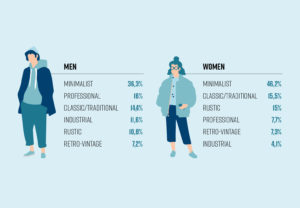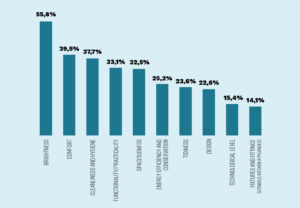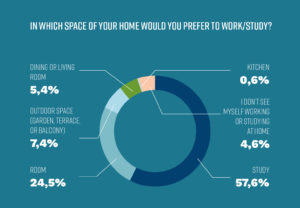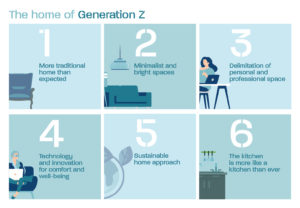A report by the Silestone Institute outlines the trends for the coming years
- Homes recover their role as shelters from permanent exposure to social media but are also transformed into an environment that accumulates, offers, and displays experiences.
- Housing types and property, style and design, technology integration, sustainability, and the importance of the kitchen space are the keys defined in this report based on a survey conducted by the Silestone Institute among Gen Zers.
- Psychologists, architects, experts in public works, educationalists, economists, chefs, and influencers have contributed to the report providing their unique qualified vision on this matter.
Madrid, 06 March 2023.- The Silestone Institute has presented its report “The future home of Gen Z in Spain,” which reveals interesting facts such as: What type of home will young people have in Spain in the coming years? Will they continue to favor co-living, or will they prefer to live in their own homes? Will they rent or buy? What features will these homes have? Will they choose to be more conservative, or will they opt for a more technological approach? Finally, what do younger generations consider more important when choosing a home?
This research highlights the new trends with the input of experts from a wide range of fields and influencers who reflect on and anticipate what young people’s homes will be like after comparing the opinions of 800 participants in the study.
Reflecting on how these homes will be is not an abstract concept about the house of the future. On the contrary, it is a need to understand the unique traits of this generation that might affect the layout of their future home. After all, this generation was born in a digital environment, which will significantly impact how they live.
The three distinguishing features of this generation that may affect their home’s future design are related to privacy, how they communicate, and being more conscious about sustainability. For centennials, a generation born between 1995 and 2010, their home recovers a role as “shelter,” stressing the need to preserve their privacy, partially lost due to their overexposure on social media. However, this real-time immersion in real and online settings also transforms the home into an environment that offers, accumulates, and displays experiences.
The following six conclusions can be drawn from the Silestone report on “The future home of Gen Z in Spain”:
1. Ambitious and traditional in housing typology and property: According to the survey, young people will choose a traditional housing model: 6 out of 10 opt for a house, and 30% choose an apartment. Furthermore, the buying culture remains unchanged. On the other hand, experts prefer a co-living model given the economic context. “But a real co-living, something they would choose because they want to and not because they have to. Choosing who you are with and whom you live with,” says Marta Peris, architect at Peris + Toral Arquitectes, one of the consulted experts. “It will be a communal space where everyone will benefit; the kitchen will be a space for socialization,” she states.
2. Layout: Minimalist (36% of the men and 46% of the women), bright (55.8% of young people), open to the outside, modular, and changeable spaces. Most survey respondents opt for homes with only a few accessories and no strident colors. However, brightness is a must. Although experts agree, they highlight the constant emergence of new trends and their blends. In this sense, Santiago Alfonso, secretary-general of the Silestone Institute, points out an increasing demand for surfaces that are pleasant to the touch “beyond the polished matt finish. Rough and textured surfaces are in,” he explains.


3. Clear distinction between work and personal space. With remote working on the rise, this is one of the issues young people are considering. A cozy study or independent room is always preferable to the kitchen or dining room for work, as it provides the required comfort and well-being. “Post-pandemic spaces are increasingly important. We all need a private space we can call our own, even though it allows us to connect with others.” This is Marisa Santamaria’s opinion, a trend researcher in design and architecture.

4. Technology, a priority for Generation Z, plays a vital role in the home, albeit in an integrated and sustainable manner. This technology is linked to personal cost savings and the sustainability of resources. “Fewer objects and more experience” is what Enrique Dans, researcher and disseminator of technological innovation, predicts. He introduces the concept of a “diffuse house,” where the virtual and the real blend. A home where people enjoy their things but also invent a virtual universe with screens or simulations. “A television set programmed as a window overlooking the sea” could be an example.
5.- Focus on sustainability. 7 out of 10 young people consider this when imagining their future home, taking a further step to help curb climate change. The choice of recycled and second-hand materials is evident. Enrique Dans claims that “with affordable prices, younger generations will use renewable energies in their homes.”
6.- The kitchen is more like a kitchen than ever. According to the report, this is the space where design is most valued, recovering the traditional purpose of this room and rejecting it as a space for work. “And with increasing interest in cooking, but far from the farce of molecular cuisine and spherifications,” states Miguel Ángel Almodóvar, sociologist, journalist, and nutrition and cuisine disseminator. “Generation Z seeks the truth, a cuisine with a cultural identity,” he claims.

SEE THE COMPLETE REPORT: https://silestoneinstitute.com/wp-content/uploads/2023/02/IS_Generacion_Z_020223_compressed.pdf
